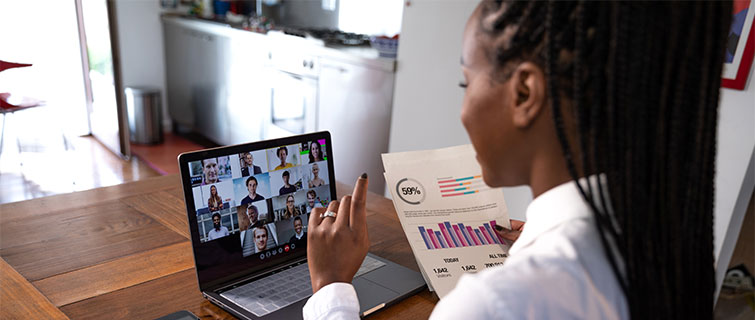
Sharon Welsh has been teaching communication skills for more than 30 years. She’s taught them to diplomats, attorneys, and CEOs; to U.S. Senators and White House appointees; and to students at Georgetown University.
For Welsh, teaching people how to communicate better has always called for shared physical presence, whether it’s a one-on-one consulting session or a class at the School of Continuing Studies, where she teaches Communication in Organizations for the Certificate in Business Administration. So, in mid-March 2020, when Georgetown, like other universities, moved all classes online because of the coronavirus pandemic, Welsh thought the new format would be inferior.
She was pleasantly surprised.
“I’ve been teaching a number of courses,” Welsh said. “And, honestly, I feel that one can communicate nearly as effectively online as in person.”
Not that it’s always fun. Not that it can’t be tiring. But if participants adhere to a few simple guidelines, Welsh said, a class or business meeting held on platforms like Zoom or Google Meet can offer advantages that even face-to-face interactions can’t match.
A Different Way to Communicate
Before we get to pitfalls and faux pas, let’s talk about the benefits. This might sound like a small thing, but it can yield big results: When you’re speaking on platforms like Zoom and Google Meet, you can affix your notes to the screen’s border. So, unlike giving an in-person lecture, you don’t have to periodically look down at your notes—and risk losing your audience, if only for a second—or worse, search the ceiling or the floor for what it is you want to say. Thanks to the wonders of Zoom, and the humble Post-it Note, you are in command.
Eye contact with your audience is always important, whether you’re speaking in person or on Zoom. You can optimize that online by setting your screen to what Zoom calls “Gallery View,” Welsh said, and glance at members of your class or lecture audience, helpfully arranged “Brady-Bunch” style, to convey that you’re speaking to each one. And, by seeing everyone’s face close up, you can receive feedback that you can use to adjust your presentation in real time if, for example, some people seem distracted or confused.
There’s something about standing up while giving a talk that lends a note of authority to your presentation, Welsh said. On the downside, it can also make you more nervous than sitting down, so there’s a tradeoff there.
On Google Meet and Zoom, there is no expectation for you to stand up (that could look a little weird) so there’s no downside to sitting down—you can still speak with authority.
“I always have my students and clients stand when they give presentations in person. It conveys more authority, more credibility,” Welsh said. “However, we can see knocking knees, we can see swaying back and forth. Those are not visible on Zoom, as we’re really just seeing your upper body.”
New Medium, New Expectations
Early on in the pandemic, there was some talk about people being subtly put off, perhaps unconsciously, by Zoom because of the time lag that can occur between words and the facial expressions that accompany them. While there may be some truth to this, Welsh said, the more experience people have with the technology, the more they anticipate these delays and accept them, much in the same way that we expect a TV news reporter, when asked a question by the anchor, to pause a few seconds before answering. It’s not that the reporter doesn’t know what the anchor is talking about; she’s waiting for the audio to come through, and we’ve come to accept that as normal communication for that medium.
That said, the medium also has some requirements for listeners that don’t apply to in-person classes or meetings. For example, say you’re at your regular Monday morning check-in meeting, one that you might feel isn’t really necessary yet takes 45 minutes out of your day.
Now (not that you would do this, of course) but say someone in the meeting is going on about something that doesn’t concern you, you might be tempted to check the weather forecast, last night’s box score, or the latest meme on Twitter. In an in-person meeting, you would probably not be noticed because people tend to face whoever is speaking, Welsh said. But in Gallery View, everyone is “on stage” and visible at close range, so you will need to be engaged at all times.
An Efficiency Boost
If there’s one noticeable drawback to Zoom and similar platforms it is this: It can be tiring to look at a screen and concentrate for hours on end. That’s why Welsh breaks up her class time into shorter sessions when she teaches online.
“People need breaks, and I have them do exercises and other course-related work during the breaks so they get away from the screen,” Welsh said. “Because the Zoom screen can be exhausting. It’s harder to stay focused on a flat screen.”
These potential drawbacks aside, platforms like Zoom and Google Meet have made communication more efficient and less time consuming, in large part simply by eliminating the need for long commutes to in-person classes or meetings, thus providing more time for skills development.
“Virtual platforms have proven to become highly successful means of communication,” Welsh said. “Communication with real people, in real time.”
